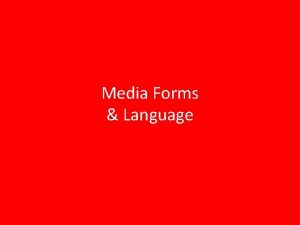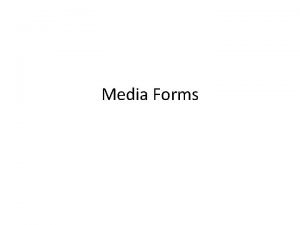Media Forms Language Media Forms The type of











- Slides: 11

Media Forms & Language

Media Forms The type of media text or media platform that we are studying. Over the centuries, humans have developed different ways of communicating with one another, and have especially sought ways of communicating a single message to large groups, via a mass medium. Various scientific and technological developments have led to the creation of mass media forms. In Media Studies, the word ‘text’ is used to describe any media form or product.

Forms Types 1. 2. 3. 4. Print – Books, Magazine, Newspaper Radio Video – Television, Cinema Internet – Web, Social

Media Language The way in which the meaning of a media text is conveyed to the audience. One of the ways Media Language works is to convey meaning created through signs and symbols (Codes). The key to understanding the meanings in text is the use of codes.

• Codes are rules or conventions by which signs are put together to create meaning. Codes are usually socially constructed and agreed upon by a society as a whole. • Some of the most common codes used in media are:

• • Dress codes Color codes Non-verbal codes/Proxemic Technical codes – These relate to the way in which particular texts are reproduced and the media used

Straight from Cambridge “Media language refers to the ways in which media producers make meaning and how audiences come to be literate in ‘reading’ such meaning within the medium. For example’ ‘the language of film’. These medium specific languages will often be closely connected to other media concepts such as narrative and genre and candidates are at liberty to make such connections to a greater or lesser extent in their answers. ”

Codes & Conventions Codes: how sign and symbols are put together (usually in a sequence) to create meaning Conventions: rules or long accepted ways of doing things…through repeated experiences, audiences become familiar with these

Understanding Codes & Conventions • Encoding is the process by which a source (the maker) performs conversion of information into the text. Decoding is the reverse process of converting text into information understandable by a receiver. • Encoding is the process of formulating messages, that is, person's skill of using language to convey messages. Decoding is the process of analyzing the message, that is, a person's skill of understanding language. • Language is made up of codes established through rules and regulations (conventions).

Types of Codes Technical Codes: Camera techniques, framing, depth of field, lighting, exposure and juxtaposition Symbolic Codes Objects, setting, body language, clothing and color Written Codes Headlines, captions, speech bubbles, language style

• • Dress codes Color codes Non-verbal codes/Proxemic Technical codes – These relate to the way in which particular texts are reproduced and the media used.




















